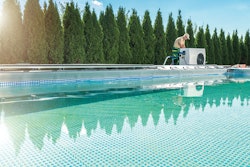
I'd like to follow up with a more detailed question regarding the nature of concrete used to create in-ground pool and spa structures. About four years ago by my count, but likely longer than that, the question of the ideal compression strength for pneumatically placed concrete (i.e. gunite or shotecrete) in pool shells began circulating amongst engineers and builders.
For years, the pool and spa industry loosely maintained a standard of 2,500 psi, a spec still used by many, the notion being that for the vast majority of installations and assuming a proper structural design relative to soil conditions and other forces, 2,500 and above is acceptable. For as long as anyone could remember this had always been the standard and common practice, though no one (at least no one I could find) had any verifiable idea of where that standard originated or why.
In 2007, I was conducting an interview with a talented builder, Bill Drakeley of Drakely Swimming Pool Company, LLC (Bethlehem, Conn.) discussing the issue of proper shotcrete application, a subject near and dear to Drakeley's heart. (He's a Certified Examiner of the Shotcrete Process and a Certified Nozzleman, both accreditations earned via the American Concrete Institute (ACI).)
During our discussion, Drakeley shared his view that concrete pools and spas could be made functionally watertight by achieving compression strengths of 4,000 psi or higher, and that hitting the mark also meant structures that were far more structurally reliable than those at 2,500. Subsequently, Drakeley and a group of others began debating the issue in the pages of various trade journals and seminars, a set of exchanges that have become at times heated and personal in nature.
In 2009, those arguing for the higher standard were handed a major victory when the American Shotcrete Association (ASA) adopted standards maintained by ACI (ACI 318.08) calling for 4,000 psi as a minimum standard, as well as 4,500 psi in freeze/thaw conditions and 5,000 psi in coastal areas where chloride intrusion is a possible concern.
Nonetheless, many in the pool and spa industry, some with terrific credentials, have remained steadfast maintaining that the 2,500 psi standard should still be considered acceptable. The rationales vary, but they all essentially boil down to the argument that the vast majority of pools built to that standard have not experienced structural failures and those that have, the failures have been due to factors other than compression strength.
Those supporting the higher standard argue that when taking into account the ACI and ASA positions on the issue and in looking at other types of in-ground concrete structures, it only makes sense to update the pool and spa industry's practice by increasing recommended compression strength.
This week's question: Where do you stand? Should the industry increase the standard for concrete's compression strength, or stick with the status quo?












































